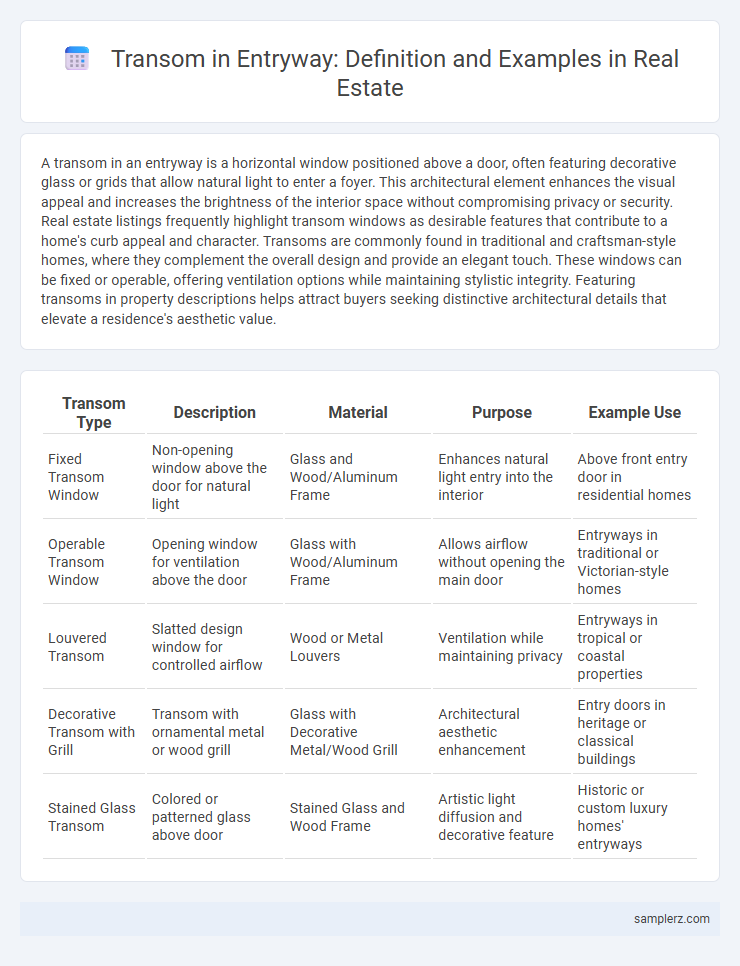A transom in an entryway is a horizontal window positioned above a door, often featuring decorative glass or grids that allow natural light to enter a foyer. This architectural element enhances the visual appeal and increases the brightness of the interior space without compromising privacy or security. Real estate listings frequently highlight transom windows as desirable features that contribute to a home's curb appeal and character. Transoms are commonly found in traditional and craftsman-style homes, where they complement the overall design and provide an elegant touch. These windows can be fixed or operable, offering ventilation options while maintaining stylistic integrity. Featuring transoms in property descriptions helps attract buyers seeking distinctive architectural details that elevate a residence's aesthetic value.
Table of Comparison
| Transom Type | Description | Material | Purpose | Example Use |
|---|---|---|---|---|
| Fixed Transom Window | Non-opening window above the door for natural light | Glass and Wood/Aluminum Frame | Enhances natural light entry into the interior | Above front entry door in residential homes |
| Operable Transom Window | Opening window for ventilation above the door | Glass with Wood/Aluminum Frame | Allows airflow without opening the main door | Entryways in traditional or Victorian-style homes |
| Louvered Transom | Slatted design window for controlled airflow | Wood or Metal Louvers | Ventilation while maintaining privacy | Entryways in tropical or coastal properties |
| Decorative Transom with Grill | Transom with ornamental metal or wood grill | Glass with Decorative Metal/Wood Grill | Architectural aesthetic enhancement | Entry doors in heritage or classical buildings |
| Stained Glass Transom | Colored or patterned glass above door | Stained Glass and Wood Frame | Artistic light diffusion and decorative feature | Historic or custom luxury homes' entryways |
What Is a Transom in an Entryway?
A transom in an entryway refers to a horizontal window or panel located above a doorframe, designed to allow natural light and ventilation into a space while maintaining privacy and security. Often made of glass, transoms enhance the architectural appeal of homes by creating a more open and inviting atmosphere without compromising the structural integrity of the doorway. In real estate, transom windows are valued for their ability to increase curb appeal and boost natural lighting, which can improve energy efficiency and interior comfort.
Historical Significance of Entryway Transoms
Entryway transoms have long served as architectural features that enhance both aesthetic appeal and functionality, allowing natural light and ventilation into historical homes while maintaining privacy. In Colonial and Victorian-era buildings, transoms often featured intricate stained glass or etched designs, reflecting the craftsmanship and stylistic trends of their periods. These transom windows remain significant in preserving the historical integrity of heritage properties by showcasing period-specific materials and construction techniques.
Types of Transoms Used in Entryways
Transoms in entryways commonly include fixed glass transoms that allow natural light to brighten interior spaces while maintaining privacy. Operable transoms, such as hopper or awning styles, provide ventilation and enhance airflow without compromising security. Decorative stained glass transoms add architectural interest and elevate curb appeal in both traditional and modern real estate designs.
Common Materials for Entryway Transoms
Entryway transoms are commonly crafted from materials such as wood, aluminum, and fiberglass, each offering unique benefits in durability and design versatility. Wood transoms provide a classic, warm aesthetic ideal for traditional homes, while aluminum transoms offer enhanced strength and low maintenance for modern or industrial styles. Fiberglass transoms combine energy efficiency with resistance to weathering, making them a popular choice for residential entryways requiring long-lasting performance.
Benefits of Adding a Transom Above Your Door
Adding a transom above your entryway door enhances natural light flow, brightening interior spaces without compromising privacy or security. Transoms improve ventilation by allowing warm air to escape while maintaining structural integrity and aesthetic appeal. Incorporating a transom can also increase curb appeal and potentially raise property value by contributing to an elegant, timeless architectural feature.
How Transoms Enhance Entryway Lighting
Transoms, installed above entryway doors, significantly enhance natural lighting by allowing sunlight to filter into interior spaces without compromising privacy or security. These horizontal windows increase ambient brightness, reducing the need for artificial lighting during the day and creating an inviting atmosphere. Incorporating transoms in entryways also elevates architectural appeal while maximizing energy efficiency in residential and commercial real estate.
Modern vs. Classic Transom Designs for Entryways
Modern transom designs for entryways often feature sleek, minimalist frames with large panes of clear or frosted glass that maximize natural light and create a clean, contemporary aesthetic. Classic transom designs typically incorporate intricate muntin patterns or stained glass, adding decorative detail and historic charm to traditional entryways. Both styles enhance the visual impact of the doorway while improving ventilation and providing additional daylight.
Examples of Decorative Entryway Transoms
Decorative entryway transoms often feature intricate stained glass designs that add both natural light and artistic appeal to front doors. Classic examples include arched transoms with geometric patterns or floral motifs that complement Victorian or Craftsman-style homes. Modern transoms may incorporate frosted or etched glass to provide privacy while enhancing the contemporary entryway aesthetics.
Entryway Transom Installation Considerations
Entryway transom installation enhances natural light and ventilation while adding architectural interest to a home's facade. Key considerations include ensuring proper structural support, selecting energy-efficient glazing, and complying with local building codes to maximize both functionality and aesthetic appeal. Accurate measurements and professional sealing prevent drafts and water infiltration, maintaining the entryway's durability and comfort.
Boosting Home Value with Entryway Transoms
Entryway transoms enhance natural light, creating an inviting and spacious atmosphere that can significantly boost a home's market appeal. Incorporating decorative or energy-efficient transom windows elevates curb appeal while improving energy savings, factors highly valued by buyers. Real estate experts report that homes featuring stylish entryway transoms often experience increased appraisal values and faster sale times.

example of transom in entryway Infographic
 samplerz.com
samplerz.com